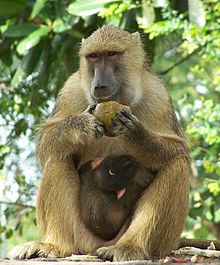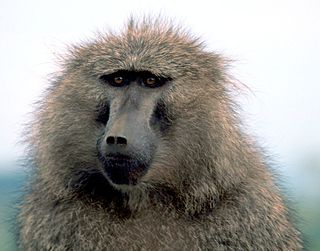
Primatology is the scientific study of non-human primates. It is a diverse discipline at the boundary between mammalogy and anthropology, and researchers can be found in academic departments of anatomy, anthropology, biology, medicine, psychology, veterinary sciences and zoology, as well as in animal sanctuaries, biomedical research facilities, museums and zoos. Primatologists study both living and extinct primates in their natural habitats and in laboratories by conducting field studies and experiments in order to understand aspects of their evolution and behavior.
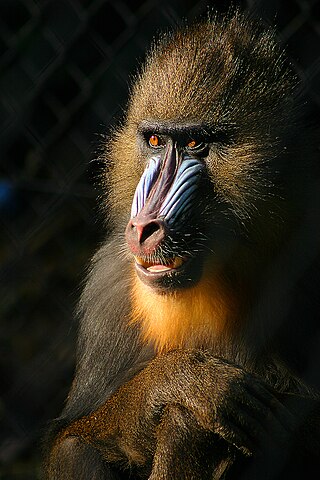
Mandrillus is a genus of large Old World monkeys distributed throughout central and southern Africa, consisting of two species: M. sphinx and M. leucophaeus, the mandrill and drill, respectively. Mandrillus, originally placed under the genus Papio as a type of baboon, is closely related to the genus Cercocebus. They are characterised by their large builds, elongated snouts with furrows on each side, and stub tails. Both species occupy the west central region of Africa and live primarily on the ground. They are frugivores, consuming both meat and plants, with a preference for plants. M. sphinx is classified as vulnerable and M. leucophaeus as endangered on the IUCN Red List of Threatened Species.

The gelada, sometimes called the bleeding-heart monkey or the gelada baboon, is a species of Old World monkey found only in the Ethiopian Highlands, living at elevations of 1,800–4,400 m (5,900–14,400 ft) above sea level. It is the only living member of the genus Theropithecus, a name derived from the Greek root words for "beast-ape". Like its close relatives in genus Papio, the baboons, it is largely terrestrial, spending much of its time foraging in grasslands, with grasses comprising up to 90% of its diet.

The olive baboon, also called the Anubis baboon, is a member of the family Cercopithecidae Old World monkeys. The species is the most wide-ranging of all baboons, being native to 25 countries throughout Africa, extending from Mali eastward to Ethiopia and Tanzania. Isolated populations are also present in some mountainous regions of the Sahara. It inhabits savannahs, steppes, and forests. The common name is derived from its coat colour, which is a shade of green-grey at a distance. A variety of communications, vocal and non-vocal, facilitate a complex social structure.
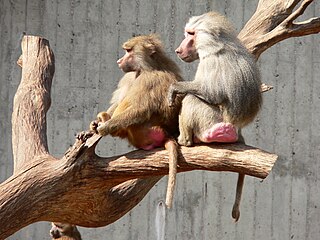
The hamadryas baboon is a species of baboon within the Old World monkey family. It is the northernmost of all the baboons, being native to the Horn of Africa and the southwestern region of the Arabian Peninsula. These regions provide habitats with the advantage for this species of fewer natural predators than central or southern Africa where other baboons reside. The hamadryas baboon was a sacred animal to the ancient Egyptians and appears in various roles in ancient Egyptian religion, hence its alternative name of 'sacred baboon'.

The Guinea baboon is a baboon from the Old World monkey family. Some (older) classifications list only two species in the genus Papio, this one and the hamadryas baboon. In those classifications, all other Papio species are considered subspecies of P. papio and the species is called the savanna baboon.

The chacma baboon, also known as the Cape baboon, is, like all other baboons, from the Old World monkey family. It is one of the largest of all monkeys. Located primarily in southern Africa, the chacma baboon has a wide variety of social behaviours, including a dominance hierarchy, collective foraging, adoption of young by females, and friendship pairings. These behaviors form parts of a complex evolutionary ecology. In general, the species is not threatened, but human population pressure has increased contact between humans and baboons. Hunting, trapping, and accidents kill or remove many baboons from the wild, thereby reducing baboon numbers and disrupting their social structure.

Chlorocebus is a genus of medium-sized primates from the family of Old World monkeys. Six species are currently recognized, although some people classify them all as a single species with numerous subspecies. Either way, they make up the entirety of the genus Chlorocebus.

Social grooming is a behavior in which social animals, including humans, clean or maintain one another's bodies or appearances. A related term, allogrooming, indicates social grooming between members of the same species. Grooming is a major social activity and a means by which animals who live in close proximity may bond, reinforce social structures and family links, and build companionship. Social grooming is also used as a means of conflict resolution, maternal behavior, and reconciliation in some species. Mutual grooming typically describes the act of grooming between two individuals, often as a part of social grooming, pair bonding, or a precoital activity.
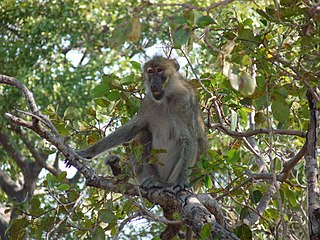
The Kinda baboon is a species of baboon present in the miombo woodlands of Angola, the Democratic Republic of the Congo, Zambia, and possibly western Tanzania. It was once considered a subspecies of the yellow baboon, then distinct enough to merit status as full species under the phylogenetic species concept.
The Amboseli Baboon Project is a long-term, individual-based research project on yellow baboons in the Amboseli basin of southern Kenya. Founded in 1971, it is one of the longest-running studies of a wild primate in the world. Research at the Amboseli Baboon Project centers on processes at the individual, group, and population levels, and in recent years has also included other aspects of baboon biology, such as genetics, hormones, nutrition, hybridization, parasitology, and relations with other species. The project is affiliated with the Department of Ecology and Evolutionary Biology at Princeton University, the Department of Biology and the Evolutionary Anthropology Department at Duke University, and the Department of Biological Sciences at the University of Notre Dame.

Baboons are primates comprising the genus Papio, one of the 23 genera of Old World monkeys, in the family Cercopithecidae. There are six species of baboon: the hamadryas baboon, the Guinea baboon, the olive baboon, the yellow baboon, the Kinda baboon and the chacma baboon. Each species is native to one of six areas of Africa and the hamadryas baboon is also native to part of the Arabian Peninsula. Baboons are among the largest non-hominoid primates and have existed for at least two million years.

Dinopithecus is an extinct genus of very large primates closely related to the baboon, that lived during the Pliocene and Pleistocene epochs in South Africa and Ethiopia. It was named by British paleontologist Robert Broom in 1937. The only species currently recognized is Dinopithecus ingens, as D. quadratirostris has been reassigned to the genus Soromandrillus. It is known from several infilled cave sites in South Africa, all of early Pleistocene age, including Skurweberg, Swartkrans, and Sterkfontein.
Hepatocystis is a genus of parasites transmitted by midges of the genus Culicoides. Hosts include Old World primates, bats, hippopotamus and squirrels. This genus is not found in the New World. The genus was erected by Levaditi and Schoen, 1932, as Hepatocystes.

Sexual swelling, sexual skin, or anogenital tumescence refers to localized engorgement of the anus and vulva region of some female primates that vary in size over the course of the menstrual cycle. Thought to be an honest signal of fertility, male primates are attracted to these swellings; preferring, and competing for, females with the largest swellings.
In biology, paternal care is parental investment provided by a male to his own offspring. It is a complex social behaviour in vertebrates associated with animal mating systems, life history traits, and ecology. Paternal care may be provided in concert with the mother or, more rarely, by the male alone.
Jeanne Altmann, born March 18, 1940, in New York City, is a professor emerita and Eugene Higgins Professor of ecology and evolutionary biology currently at Princeton University. She is known for her research on the social behaviour of baboons and her contributions to contemporary primate behavioural ecology. She is a founder and co-director of the Amboseli Baboon Research Project. Her paper in 1974 on the observational study of behaviour is a cornerstone for ecologists and has been cited more than 10,000 times. She is a Fellow of the National Academy of Sciences, and a member of the American Philosophical Society (2020)
Susan C. Alberts is an American primatologist, anthropologist, and biologist who is the current Chair of the Department of Evolutionary Anthropology at Duke University; previously, she served as a Bass fellow and the Robert F. Durden Professor of Biology at Duke. She currently co-directs the Amboseli Baboon Research Project with Jeanne Altmann of Princeton University. Her research broadly studies how animal behavior evolved in mammals, with a specific focus on the social behavior, demography, and genetics of the yellow baboon, although some of her work has included the African elephant. She was elected a fellow of the American Academy of Arts and Sciences in 2014, won the Cozzarelli Prize of the National Academy of Sciences in 2016, and was elected a fellow of the National Academy of Sciences in 2019.

Primate sociality is an area of primatology that aims to study the interactions between three main elements of a primate social network: the social organisation, the social structure and the mating system. The intersection of these three structures describe the socially complex behaviours and relationships occurring among adult males and females of a particular species. Cohesion and stability of groups are maintained through a confluence of factors, including: kinship, willingness to cooperate, frequency of agonistic behaviour, or varying intensities of dominance structures.
Vertical transmission of symbionts is the transfer of a microbial symbiont from the parent directly to the offspring. Many metazoan species carry symbiotic bacteria which play a mutualistic, commensal, or parasitic role. A symbiont is acquired by a host via horizontal, vertical, or mixed transmission.
